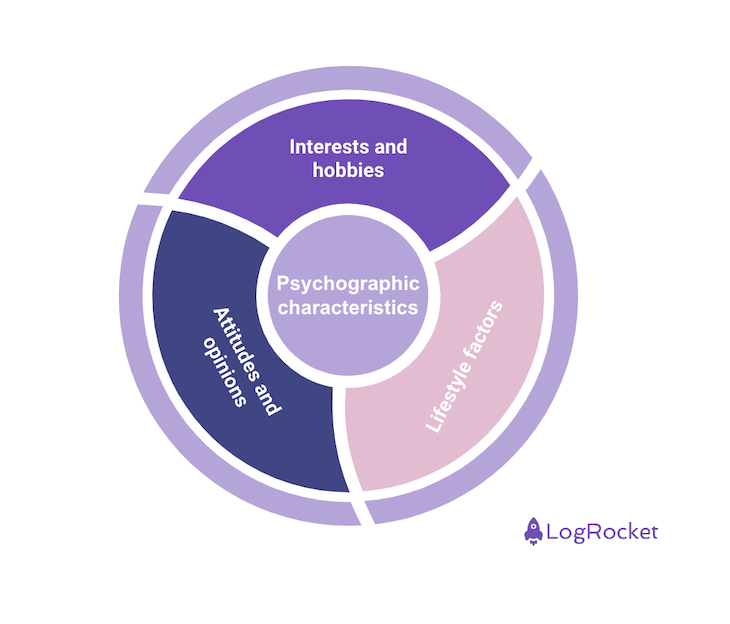
At the heart of every successful product lies a critical component: a deep understanding of the individuals for whom the product is intended. Without profound user understanding, there’s a risk of investing valuable effort and talent in building and marketing a product that fails to reach or resonate with the intended audience.
To gain a comprehensive grasp of users, market segmentation comes into play. Market segmentation involves systematically dividing the broader target market into smaller user segments within which users share similar traits and are likely to respond to your product or marketing efforts in a similar way.
Traditionally, market segmentation relied heavily on basic demographic categories like age, gender, location, profession, etc. This is known as demographic segmentation.
Modern market segmentation, however, goes beyond mere demographics. It delves deeper into understanding users and the psychology behind them buying a product. This method is known as psychographic segmentation.
In this article, you will learn what psychographic segmentation is and how to gather its insights.
Psychographic segmentation is a technique where segments are defined based on psychological traits that influence product adoption. It goes beyond surface-level demographics and explores people’s beliefs, aspirations, and ambitions. It defines segments based on how people think and what they aspire their life to be.
The advantage of psychographic segmentation is that it does not just aim to understand who the users are and their current state (as it’s the case with demographic segmentation). Instead its greater focus lies on understanding where users want to be, the state they desire to achieve.
Two examples of psychographic segments are:
Psychographics bring significant value to your product team. While they provide many benefits, the most important two are:
Product teams who have a clear understanding of their target audience have a substantial advantage in developing products with impact.
Product managers possess better intuition to decide which product features can deliver high value to users. UX designers are better positioned to design user-friendly products where workflows in the product naturally align with users’ thought patterns.
This synergy amplifies the value of the product and increases the adoption rate among the end users.
Another important advantage of psychographics is that it significantly elevates marketing communication.
Marketing messages become tailored to users’ psychological traits, beliefs, and values. Marketing campaigns become personalized to align the individual preferences. This makes marketing communication much more effective because it encapsulates users’ real desires and needs.
And when the communication resonates with users’ shared values and beliefs, it creates an emotional bond between them and the company.
Now let’s look at some examples of psychographic attributes. You can group them into key categories like:

These attributes give insight into how users spend their free time — whether on outdoor activities, on specific hobbies, or online.
Imagine you’re developing a fitness app that offers workout routines and nutrition tips. Understanding that a substantial segment of your users favors outdoor activities like hiking and running can steer your product strategy. You could incorporate features that offer specialized workout plans for running marathons or hiking preparation, or nutrition advice tailored to these segments. You can also include social features that allow users to connect with others who share the same interests.
By following your users’ hobbies and interests, your fitness application becomes a personalized resource that aligns with users’ interests, resulting in increased engagement and user satisfaction.
This category goes deep in the individual perspectives and beliefs. It reveals how users perceive the world and make judgments on various subjects. This knowledge is a great tool to craft your marketing messages, or to build product features that deeply resonate with users’ values.
For example, you might be developing a travel booking website. If a significant portion of your target users have a strong attitude toward sustainability, you can tailor your product offering accordingly. You might highlight sustainable accommodations, or provide information on sustainable travel practices.
This category provides an insight into users’ daily routines, choices and values. it shows whether users are health-conscious, leisure-focused, or knowledge-oriented. These are great insights for product managers, marketers and UX designers to understand which product offerings will add value to your users, or which communication message will resonate with them.
You could be working on a product in a field that doesn’t initially seem connected to these attributes. Yet, the value they bring should not be underestimated. Even if the link isn’t obvious, grasping these psychographic traits offers a vivid portrait of your users — how they think, what captures their attention, their values, and emotions. This clarity is vital in constructing a product that’s not just necessary but also truly enjoyable for people to use.
Gathering psychographic data today has become somewhat easier compared to before, thanks to advancements in technology and data collection methods. With the developments of digital platforms, online interactions, and social media, users leave digital footprints that provide valuable psychographic insights.
Here are some effective ways to collect this data:
Surveys and interviews are still the key pillars in user research as well as uncovering psychographic insights. Surveys provide a structured way to gather data from a broader audience and in a scalable way. Using surveys with a blend of multiple-choice and open-ended questions, you can get a good view of the psychographic characteristics of the target audience and identify any patterns and segments.
Interviews, on the other hand, offer a deeper dive. Through one-on-one conversations, participants share their motivations, values, and aspirations, giving you an intimate understanding of their thoughts. With this method you can in a way humanize data you have collected, and grasp the why behind the data.
Social media is another goldmine for psychographic data today. Most people share their thoughts, interests, and activities openly on these platforms. And even people who don’t share any views already reveal a certain side of their psychology.
By analyzing the content the users engage with, or the discussions they participate in, you can get a good view of their values, interests, and opinions.
This is a method of collecting psychographic data by observing how users interact with digital platforms such as websites, applications, and online content. It involves monitoring and analyzing the actions users take while navigating through online spaces. The pages they visit, the time they spend on a page, the search queries they use provide valuable insight of their interests and behavior patterns.
What a user has been purchasing in the past gives also a great view on what their values and preferences are and what they are willing to pay for. For instance, a person investing in eco-friendly products might prioritize sustainability. Reviewing purchase patterns and product reviews can uncover hidden motivations and unmet needs. It’s a tangible reflection of their inner psychology, revealing what matters most to them.
Let’s delve into the contrasts between demographic and psychographic attributes by examining the following:
Demographic data encompasses fundamental parameters like age, gender, location, education. This data is often accessible publicly or can be gathered via simple surveys and forms.
On the contrary, psychographic data goes into deeper and nuanced dimensions of individuals’ lives, capturing their values, attitudes, beliefs, and behaviors. Collecting this data involves more elaborative research methods. While technology has eased the process to some extent, collecting this data is still much more difficult and expensive compared to demographic data.
Another concern is security, privacy and ethical considerations regarding the data footprint of your users. They are important aspects that should be approached carefully. While demographic data is in general less sensitive, psychographic data can be quite sensitive. Finding the right balance between gathering insightful data and respecting user privacy is crucial, ensuring that data is collected responsibly and transparently.
While demographic data merely scratches the surface of user understanding by categorizing external traits like age and gender, psychographic data delves much deeper. It provides profound insights into user motivations, behaviors, preferences, and aspirations, yielding a deep understanding of their psychological attributes.
This profoundness is why the value of psychographic data surpasses that of demographic data alone. It offers insights into users’ pain points, challenges, desires, and envisioned states of being. Such information is pivotal in building the right product, tailoring an offer aligned with users’ needs, and effectively communicating product value propositions.
Psychographic data has a more dynamic nature compared to demographic data. While demographic attributes tend to remain relatively stable over time, psychographic data is more prone to change. Psychological attributes can evolve as individuals grow, learn, and experience new situations.
This dynamics adds another layer of complexity to understanding user behavior and preferences. Staying informed of these dynamic changes in psychographic data is important for maintaining accurate insights of this data.
While demographics and psychographics are distinct concepts, they should be viewed as complementary approaches. When used together, they can yield optimal outcomes.
Demographics come into play when targeting specific geographic areas or individuals within particular professions.
In contrast, psychographics find their strength in the realm of digital products that span across different geographic boundaries. They are particularly valuable for products targeting individuals sharing specific interests, as these traits can be present across various locations, ages, or professions.
Psychographics embodies the essence of user understanding, serving as a valuable tool for both product managers and product marketers. This is where psychology intertwines into product development, infusing empathy and deep insights into user thoughts and behaviors.
While collecting and maintaining psychographic data might present challenges, product managers should not overlook this approach. Depending on your domain and company’s maturity, you should choose the extent to which you delve into psychographics. The better your understanding of users, the higher the chances of building a successful product that resonates with them.
Featured image source: IconScout

LogRocket identifies friction points in the user experience so you can make informed decisions about product and design changes that must happen to hit your goals.
With LogRocket, you can understand the scope of the issues affecting your product and prioritize the changes that need to be made. LogRocket simplifies workflows by allowing Engineering, Product, UX, and Design teams to work from the same data as you, eliminating any confusion about what needs to be done.
Get your teams on the same page — try LogRocket today.

A practical five minute revenue estimation method to help product managers compare ideas, drop low impact features, and prioritize smarter.

A practical guide for PMs who want to stop being bottlenecks, delegate smarter, and lead teams effectively with a clear ownership framework.

Stop letting unreliable data block features. Treat data as inventory to track quality, ownership, and ship with confidence.

Learn why slide decks slow teams down and explore better tools like whiteboards, PRDs, and prototypes to improve collaboration and alignment.